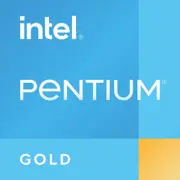Intel Pentium Gold G6400

Intel Pentium Gold G6400: A Budget Processor for Basic Tasks in 2025
April 2025
Key Features: Architecture and Performance
The Intel Pentium Gold G6400, released in 2020, remains relevant for budget builds due to its energy efficiency and low cost. Based on the Comet Lake microarchitecture (14nm), it features 2 cores and 4 threads (thanks to Hyper-Threading), allowing it to handle basic multitasking scenarios.
Key Features:
- Base Clock Speed: 4.0 GHz (without Turbo Boost).
- L3 Cache: 4 MB — sufficient for basic applications.
- Integrated Graphics: Intel UHD Graphics 610 running at 1.05 GHz, supporting 4K via HDMI.
- TDP 58W — low power consumption for office PCs.
Performance:
According to Geekbench 6 tests (2025), the processor scores 807 points in single-threaded mode and 1677 points in multi-threaded mode. This performance is adequate for working with office applications, web browsing, and light graphic editors. For instance, in Microsoft Office 2025, it demonstrates smooth operation even with large Excel spreadsheets.
Compatible Motherboards: Sockets and Chipsets
The Pentium G6400 utilizes the LGA 1200 socket, which limits motherboard choices to outdated but affordable models.
Compatible Chipsets:
- H410/B460/H470: optimal for this processor. H410 chipsets are the cheapest (starting at $60) but lack PCIe 4.0 and USB 3.2 Gen 2.
- Z490: an excessive choice since the processor does not support overclocking.
Examples of motherboards in 2025:
- ASRock H410M-HDV ($65): mini-ATX, 2 DDR4 slots.
- Gigabyte B460M DS3H ($85): 4 RAM slots, M.2 slot for NVMe.
Important: Check BIOS support when purchasing. Some motherboards require a firmware update to work with Comet Lake.
Supported Memory: DDR4 and Dual Channel Mode
The processor works with DDR4-2666 MHz in dual-channel mode. DDR5 and higher frequencies are not supported.
RAM Recommendations:
- 8GB: minimum for Windows 11 and basic tasks.
- 16GB: comfortable operation with 10+ Chrome tabs and light video editing.
Example: A set of Crucial DDR4-2666 16GB (2x8GB) costs around $45 and ensures stability.
Power Supplies: Power Calculation
With a TDP of 58W, the Pentium G6400 does not require a powerful PSU. Even considering an entry-level discrete graphics card (e.g., GTX 1650), a 400–450W PSU will suffice.
Tips:
- Choose a PSU with an 80+ Bronze certification (85% efficiency).
- Avoid no-name brands.
Examples:
- EVGA 450 BR ($50): reliable and quiet operation.
- Corsair CV450 ($55): overload protection.
Pros and Cons of the Pentium Gold G6400
Pros:
- Price: $75–85 (new, 2025).
- Energy Efficiency: suitable for compact cases.
- Integrated Graphics: no separate graphics card required.
Cons:
- 2 Cores: slows down with multiple heavy applications running simultaneously.
- No PCIe 4.0: a limitation for modern storage solutions.
- Outdated Socket: upgrading to newer Intel processors is not possible.
Use Cases: What the Processor is Suitable For
1. Office Tasks: Word, Excel, email, video conferencing.
2. Multimedia: streaming video (Netflix, YouTube 4K), music.
3. Light Gaming: Minecraft, CS:GO (on low settings, 720p), browser games.
Real Experience: A PC owner with the G6400 noted that the processor handles Adobe Photoshop 2025 (editing 12 MP photos) but "lags" when working with 3D effects.
Comparison with Competitors
AMD Athlon 3000G (Zen, 14nm):
- Pros: cheaper ($60), unlocked multiplier.
- Cons: weaker in single-threaded tasks (Geekbench 6 Single-Core: ~720).
Intel Celeron G5900:
- Pros: price ($50).
- Cons: no Hyper-Threading, only 2 threads.
Conclusion: The Pentium G6400 outperforms the Athlon 3000G in per-core performance but falls short in price.
Practical Assembly Tips
1. SSD is Essential: Kingston A400 240GB ($30) will speed up system boot times.
2. Cooling: the stock cooler is sufficient, but for quieter operation, consider a Deepcool GAMMAXX 400 ($25).
3. Case: Mini-ITX (Fractal Design Core 500) for compactness.
4. Don't Overspend on a Motherboard: H410 will suffice with headroom.
Final Conclusion: Who is the Pentium Gold G6400 Suitable For
This processor is suitable for those who:
- Are building an office PC or home media center.
- Seek maximum savings without sacrificing stability.
- Do not plan to run AAA games or professional editing software.
Alternative: If the budget allows an additional $50–70, consider the Intel Core i3-10100 (4 cores/8 threads) or the AMD Ryzen 3 4100 (Zen 2).
In 2025, the Pentium G6400 remains a niche solution, but it is still relevant for its intended tasks.
Basic
CPU Specifications
Memory Specifications
GPU Specifications
Miscellaneous
Benchmarks
Compared to Other CPU
Share in social media
Or Link To Us
<a href="https://cputronic.com/en/cpu/intel-pentium-gold-g6400" target="_blank">Intel Pentium Gold G6400</a>